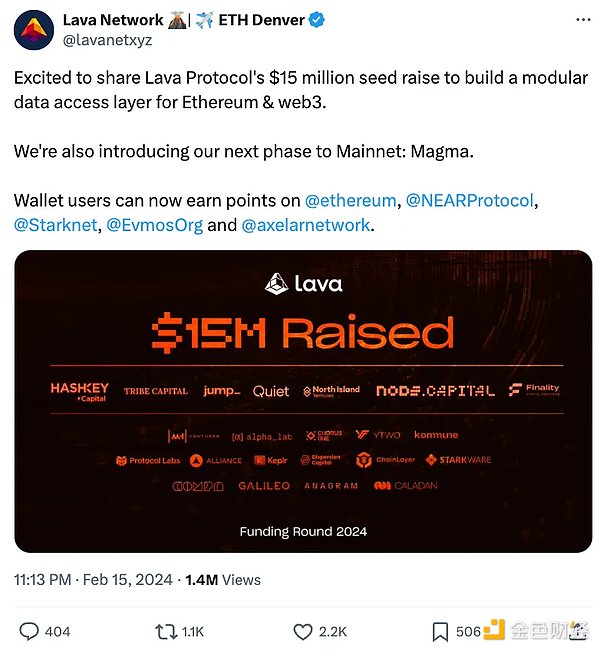Author: Revelo Intel Translation: Shan Oppa, Golden Finance
With Bitcoin prices surging to new all-time highs and altcoins (hopefully) following suit, it's easy to get caught up in the price swings. But we shouldn’t forget the underlying technology and infrastructure that supports it all. While new user-facing applications continue to emerge, similar to the previous cycle, infrastructure projects continue to be funded and delivered.
Today, we will focus on Lava Network. Lava Network serves as a dynamic P2P marketplace that connects blockchains and decentralized applications (dApps) with node providers that provide RPC services and data. With the protocol’s recent funding, upcoming mainnet launch, and points program, things are getting hotter for this modular data layer.
Lava Network Introduction
Lava Network is a modular data network that provides developers with scalable access to any rollup or blockchain. The word “modular” is being thrown around a lot lately, but what does it really mean? In the context of Lava, it allows any blockchain to access its data network to help scale. Lava is a network of node providers that provide access to data and RPC. It basically helps make these things more accessible to various blockchains.
The need for such services has been demonstrated, with blockchain opting for DA (data availability) solutions like EigenDA and Celestia to serve this purpose. Lava Network removes the middleman, allowing blockchain access to features such as censorship resistance, transparency, and privacy. It may be better to use a network of nodes than to rely on just one node or use multiple node providers.
Lava Network co-founder Yair Cleper used Amazon's business model to explain the role of Lava Network.
Peer-to-Peer SDK: Allows direct communication between decentralized applications and multiple providers without middlemen. Providers are rewarded based on reviews. In this case, the decentralized application is the customer and the P2P provider plays the role of the Amazon merchant. Providers are rewarded for their contributions after transactions settle. There are already over 300 providers, large and small, on the Lava Network.
Specifications: "Champions" in Lava can define RPC APIs based on specific chains. They provide these specifications to the community and nodes provide Vendors can launch nodes based on these specifications. Specifications can be understood as products provided by Amazon itself. "Champions" are those who provide specifications, and they also define RPCs for specific and upcoming chains.
Just like Amazon has many providers, Lava Network's trust is distributed across multiple providers, ensuring scalability and reliability. Lava's goal is to become the first to access blockchain data A one-stop platform. It eliminates the need for developers to separately obtain RPC providers and index data themselves. Lava allows new chains and APIs to be quickly added as needed.
Lava Network is designed to provide flexibility, allowing developers to build where they want. It provides a dynamic marketplace where more modules and chains can be added as needed, ensuring a balance between supply and demand.
The origin of Lava Network
Lava Network was co-founded by Yair Cleper and Gil Binder, who are from Israel and own Experience building multiple startups in the Web2 space. Initially, they wanted to build a multi-chain NFT marketplace, but realized that running their own nodes for each blockchain was resource-intensive. They then explored using node providers, But found that for some chains, like Cosmos, the options were limited. Existing providers had limitations or were not reliable enough to meet their needs. They decided to focus on Ethereum first, but again faced API limitations and the need to use multiple providers
Ultimately, the team realized that the blockchain world was fragmented, complex, and slow to access data. This was An area where Lava Network hopes to step in. Lava Network aims to simplify the multi-chain landscape by providing a one-stop solution for accessing blockchain data. With Lava Network, developers can easily access relevant providers without knowing what is being used behind the scenes. Which provider. Lava Network is designed to be modular and flexible, making it easy to integrate new chains as they become popular.
Lava Network recent financing

While the funding itself doesn't exactly prove success, it shows that investors see potential in the product on offer. Notably, Lava Network recently raised $15 million in funding. The seed round was led by Jump Capital, with additional participants including: Hashkey Capital, Tribe Capital, Alliance, Node, North Island, Quiet, Finality and Dispersion Capital.
Blockdaemon, ConsenSys (Infura) and QuickNode, which have previously invested in Alchemy, also participated in this financing. Validators, ecosystems, and founders from projects such as Cosmos, Polkadot, Filecoin, StarkWare, Axelar, NEAR, Celestia, Celo, and more also joined the round. This is one example in a series of recent funding rounds announced across the crypto ecosystem.
Lava Network is clearly tightly integrated with the Cosmos community. Dozens of node providers from different ecosystems have joined Lava and will receive rewards at the end of each month.
Lava Network's mainnet launch is expected in 2024; currently, the protocol is focused on expanding its products to non-technical users. While the concept of the product may seem incomprehensible at first, the team is building communities of non-technical users in places like Korea, Turkey, Africa, and more. These communities need help in writing guides and mainnet launch documentation.
Lava will soon introduce a points system to attract non-technical users to participate. The system is designed to enable every user to bring added value to Web3 by providing access anytime, anywhere and maintaining a public good.
 JinseFinance
JinseFinance



